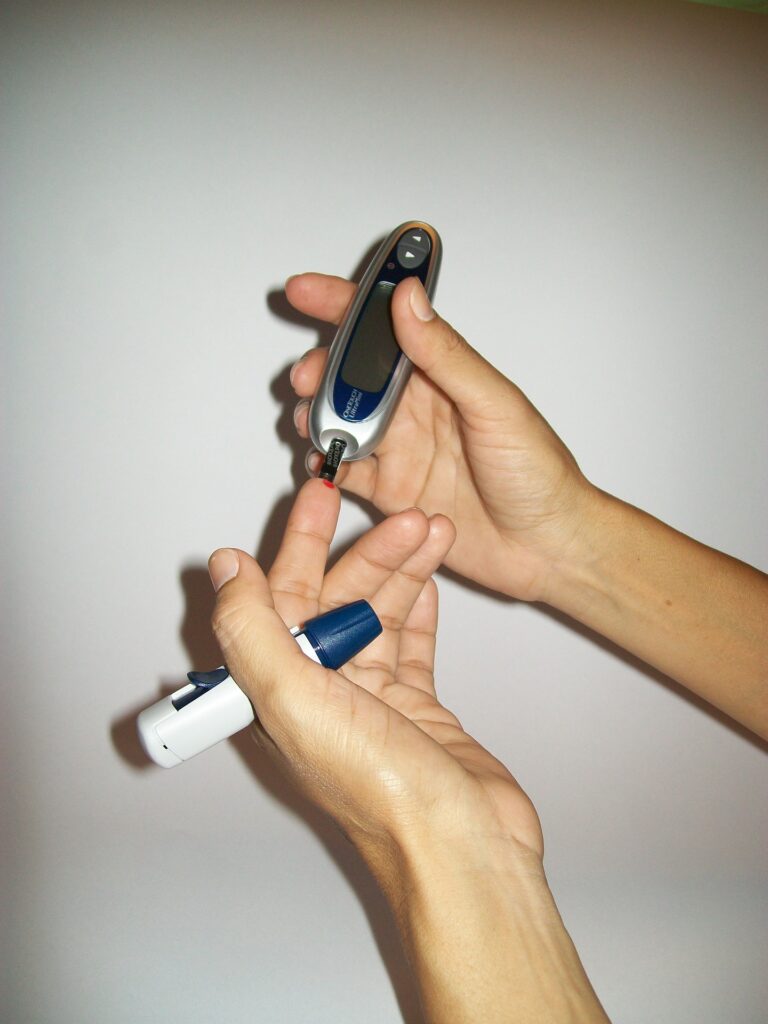Type 1 Diabetes is a medical condition in which an individual’s pancreas does not produce sufficient insulin. When a person is diagnosed with diabetes, their doctor will typically discuss the difficulties, changes, and life adaptations that accompany this chronic medical condition; however, navigating sex with Type 1 diabetes is rarely addressed. The journal Diabetes Care found that only 50 percent of men and 19 percent of women with diabetes have discussed the topic of sex with their doctors.1 Individuals with Type 1 diabetes should have thorough awareness of the sexual problems associated with this health condition. This is mainly because certain symptoms that arise during sex may be assumed as an effect of Type 1 diabetes, yet they are caused by an unrelated medical issue. For people with Type 1 diabetes, sexual issues such as nerve damage, blocked arteries, and irregular hormone patterns may arise.2 Those who keep their diabetes under control can lower the risk of developing sexual and urologic problems in the future.
Table of Contents
Communicating with Sexual Partners

If an individual with Type 1 diabetes has a sexual partner, it is recommended to establish a strong system of communication. Support and communication facilitate a foundation of trust and understanding, which can prove to be beneficial in every type of relationship. Along with discussing sexually transmitted infections (STIs) and contraception usage, individuals with Type 1 diabetes should communicate how diabetes affects their life and sexual experiences.
Sex is an intense physical activity that can cause a fast drop in blood glucose level, thus leading to potentially dangerous low blood sugar levels for individuals with Type 1 diabetes. A lack of communication can generate unwanted issues or sexual complications. For example, some people who are affected by Type 1 diabetes may feel self-conscious about their condition and try to hide it from their partners. If one’s medical condition is not discussed, the individual with Type 1 diabetes may not feel comfortable asking their partner for a break if needed, which may lead to low blood sugar and subsequent medical dangers. Therefore, establishing communication prior to sexual activity can guarantee a safer and more enjoyable experience for all involved. It is recommended for one’s partner to know how to care for someone with Type 1 diabetes if they experience a severe low blood sugar level during sex and are unable to care for themselves. As an individual affected by Type 1 diabetes, it is an important responsibility to protect oneself and supply sexual partners with the correct ways to help if medical problems arise.
Medical Responsibilities During Sex

It is essential for someone with Type 1 diabetes to be continually aware of their blood glucose level, how they are feeling, and what their physical limits are. To prevent low blood sugar, individuals with Type 1 diabetes should test their blood sugar level before and after sex. If necessary, one may choose to test their blood sugar level during sexual activity as well. Low blood sugar levels are often disguised as fatigue from physical activity, causing an individual to be unaware of a substantial drop in their blood sugar during sex. Treat sex as any physical activity: administer a blood sugar level test, eat a snack before beginning sexual activity, and be mindful of bodily feelings and changes while ‘exercising’. If there is fatigue or other unusual physical feelings during sex, do not hesitate to take a break, check blood sugar levels, and eat a snack. Every individual with Type 1 diabetes should have their preferred method of glucose intake, such as glucose tablets or food bars, and a blood glucose meter available during sexual activity. These items should be within reach, such as on a bedside table. This provides an accessible fix for blood sugar drops if they occur during sex.
Those who use insulin pumps will often disconnect their pumps before having sex. This is because insulin pump cords may become tangled or pulled during sex, which can be uncomfortable and distracting. If one is able to disconnect their pump, it must be reattached as soon as possible after sexual activity. This will avoid any severe drops in blood sugar level, which may arise if the pump is not reattached in a reasonable time.
Sexual Dysfunction
Sexual dysfunction is commonly encountered by individuals with diabetes. According to American Diabetes Association, 65 percent of women and 69 percent of men with Type 1 diabetes have had at least one issue involving sexual dysfunction.4 More often than not, this issue is caused by chronic high blood glucose.1 High blood glucose levels can cause gradual damage to nerves, which may affect the extremities, digestive system, heart muscles, and sex organs. The body’s response to sexual stimuli is governed by the autonomic nervous system, and damage to these nerves reduces blood flow and hinders normal function.5
Low Libido
Many people, both with and without diabetes, experience low sexual desire, or “low libido”. While low libido is not a sexual dysfunction, its underlying causes may lead to possible sexual dysfunctions detailed below. For those with Type 1 diabetes, a decreased interest in sex can indicate that blood glucose levels are too high.1 In addition, low libido can be caused by low testosterone levels, a common side-effect experienced by individuals with Type 1 diabetes.1 Certain medications, such as antidepressants, can also lower sexual desire. Discussing medication interaction with one’s doctor is recommended if experiencing a low libido.1
Males: Studies have indicated that males with Type 1 diabetes, especially those who are overweight, generally have twice the risk of low testosterone levels compared to males without the medical condition.1 Low testosterone levels can lead to difficulty achieving an erection, less firm erections, and difficulty achieving orgasm.3 Typically, if low testosterone is treated through weight loss techniques or testosterone therapy, sexual desire is renewed. Those with low testosterone should work with a medical professional to adjust their levels.
Females: Because low libido is relatively common in females, it has been particularly difficult to determine its main underlying causes.1 Studies indicate that females who take testosterone supplements experience an increase in sexual desire, but the long-term effects of this treatment are understudied. Thus, it is not yet confidently recommended for females to intake testosterone in order to increase sexual desire. If a female with Type 1 diabetes is experiencing low libido, it is recommended to communicate this with their doctor and discuss the possible solutions available.

Common Sexual Dysfunctions with Type 1 Diabetes
Below are some common sexual dysfunctions that occur in individuals with Type 1 diabetes. As there is a lack of research that connects sexual dysfunction to diabetes, these are not the only related sexual dysfunctions possible. If there is communication with medical professionals and proper treatment, it is possible for individuals with Type 1 diabetes to subside or completely treat their sexual dysfunction.
Males: Erectile dysfunction is defined as a consistent inability to have an erection firm enough for sexual activity. This includes the total inability to have an erection and the inability to sustain an erection for the length of time desired by the individual. Erectile dysfunction in males with diabetes is estimated to range from 20 to 75 percent.5 Males who have diabetes are two to three times more likely to have erectile dysfunction compared to males who do not. Among males with erectile dysfunction, those with diabetes may experience the problem as much as 10 to 15 years earlier than males without diabetes.5 Research suggests that erectile dysfunction may be an early marker of diabetes, particularly in males ages 45 and younger. Available treatment for erectile dysfunction includes PDE5 inhibitors (medication like Viagra and Cialis), testosterone injections or gels, constriction rings that sit at the base of the penis, vacuum pumps, support sleeves, and penile implants.1 These methods seek to increase blood flow to the genital region, which will assist in achieving and maintaining an erection. However, each of these treatments have possible health risks; it is important to discuss options and potential health outcomes with a doctor before pursuing treatment.
Nerve damage obtained by imbalanced blood glucose levels can cause retrograde ejaculation, which occurs when a male’s semen travels backward into the bladder instead of out the penis during ejaculation.2 Retrograde ejaculation forces some or all of semen to mix with urine in the bladder and leave the body through urination. A male experiencing retrograde ejaculation may notice that an unusually small quantity of semen is discharged during ejaculation or may become aware of the condition if fertility problems arise.5 If a male with Type 1 diabetes is experiencing symptoms of retrograde ejaculation, it is recommended that they visit a medical professional for diagnosis or treatment.
Females: Research regarding females with Type 1 diabetes is limited, but one study found that 27 percent of females with this condition experience sexual dysfunction.5 Nerve damage caused by Type 1 diabetes can facilitate a lack of blood flow to the genitals. Because of this, females with Type 1 diabetes can experience a lack of natural lubrication and vaginal dryness.1 Yet, vaginal dryness is often related to menopause or post-menopausal symptoms as well, in which a lack of estrogen is the cause. In this case, problems may be treated with prescription estrogen, which is available in the form of pills, patches, or creams. Additionally, menopause may cause women with diabetes to undergo unexpected drops in blood sugar levels. For younger women experiencing vaginal dryness, artificial lubrication is recommended to prevent painful sexual activity.1 Regularly performing Kegel exercises can strengthen the pelvic floor muscles and improve a woman’s sexual response cycle as well.
Urological Problems Associated with Type 1 Diabetes
More than half of individuals with Type 1 diabetes experience bladder dysfunction as a result of nerve damage.5 Overactive bladder, sphincter muscle damage, and urine retention are common symptoms experienced by those with Type 1 diabetes.5 Urine retention treatment may involve medication to promote improved bladder function, or the periodical insertion of a catheter to drain the urine. Urinary leakage treatment includes medication, strengthening the pelvic floor muscles with Kegel exercises, or possible surgery.
Because sugar leaks into urine during high blood sugar episodes, diabetic females may experience higher rates of urinary tract infections than most females do.5 Thus, it is especially important for females with diabetes to urinate after sexual activity and avoid lubricants that contain glycerin.
Concluding Remarks
Individuals with Type 1 diabetes may experience forms of sexual difficulty or dysfunction during sexual experiences. Thus, awareness of how sex interacts with Type 1 diabetes is very important. Sexual health is often pushed aside when medical conditions arise, but sex can be an important aspect of a person’s life; the discussion of sex and diabetes should not go unrecognized. With patience, understanding, medical knowledge, and communication, problems experienced with sex and Type 1 diabetes can be overcome and solved, leading to a healthier sex life.

References
- Neithercott, Tracey. “Sex and Diabetes: What You Wanted to Know.” Diabetes Forecast. The Healthy Living Magazine, Nov. 2012. Web. 26 Mar. 2015.
- McCoy, Krisha. “Sexual Issues and Type 1 Diabetes.” com. N.p., Nov. 2011. Web. 26 Mar. 2015.
- Wittert, G. “Male Sex Drive: Is The Mighty Testosterone Alone Responsible For Libido?” Medical Daily. N.p., 13 June 2013. Web. 22 Apr. 2015.
- Wessells, Hunter, et al. “Burden of Urological Complications in Men and Women With Long-Standing Type 1 Diabetes in the Diabetes Control and Complications Trial/Epidemiology of Diabetes Interventions and Complications Cohort.” Diabetes Care, vol. 41, no. 10, 2018.
- “National Diabetes Information Clearinghouse (NDIC).” Sexual and Urologic Problems of Diabetes. U.S. Department of Health and Human Services, 29 June 2012. Web. 22 Apr. 2015.
Last Updated: 02 June 2020.
